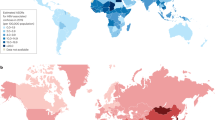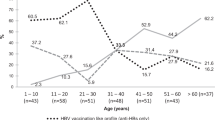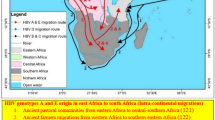Abstract
The global burden of viral hepatitis is substantial; in terms of mortality, hepatitis B virus and hepatitis C virus infections are on a par with HIV, malaria and tuberculosis, among the top four global infectious diseases. In 2016, the 194 Member States of the World Health Organization committed to eliminating viral hepatitis as a public health threat by 2030, with a particular focus on hepatitis B virus and hepatitis C virus infection. With only 10 years to go until the 2030 deadline is reached, and although much progress has been made towards elimination, there are still some important gaps in terms of policy and progress. In this Viewpoint, we asked a selection of scientists and clinicians working in the viral hepatitis field for their opinions on whether elimination of viral hepatitis by 2030 is feasible, what the key areas of progress are and what the focus for the next 10 years and beyond should be for viral hepatitis elimination.
The contributors
Andrea L. Cox is currently a Professor of Medicine, Oncology, and Immunology at The Johns Hopkins University School of Medicine, USA. Her research and clinical interests focus on hepatitis C virus, hepatitis B virus and HIV, including mechanisms through which these chronic viral infections stimulate and evade immune responses.
Manal H. El-Sayed is Professor of Paediatrics and director of the Clinical Research Centre at the Faculty of Medicine, Ain Shams University. She is a founding member of the Egyptian National Committee for Control of Viral Hepatitis since 2006. She is the secretary general of the Egyptian Liver Care Society (NGO) and board member of the EASL International Liver Foundation.
Jia-Horng Kao is the Chair Professor of the Graduate Institute of Clinical Medicine at the National Taiwan University, Taipei, Taiwan. He has published more than 550 articles on the prevention, natural history, molecular virology, pathogenesis and treatment of chronic viral hepatitis and liver cancer. He is currently the Steering Council member of The Asian Pacific Association for the Study of the Liver (APASL).
Jeffrey V. Lazarus is head of the Health Systems and Infectious Diseases team at the Barcelona Institute for Global Health (ISGlobal) and an Associate Professor at the Faculty of Medicine, University of Barcelona, Spain. He is Vice-Chairman of the board of the EASL International Liver Foundation, where he leads the work on the microelimination of hepatitis C.
Maud Lemoine is Professor and Honorary Consultant in Hepatology at Imperial College London, UK. Her research interests are mainly related to viral hepatitis in resource-limited countries, where she developed expertise on screening and management of patients with viral hepatitis. She is the head of the PROLIFICA (Prevention of Liver Fibrosis and Cancer in Africa) programme and the chief investigator and co-investigator of several studies and interventions on the prevention and management of viral hepatitis B and C in West and East Africa.
Anna S. Lok is a Professor of Internal Medicine, Director of Clinical Hepatology, and Assistant Dean for Clinical Research at the University of Michigan, USA. She has published more than 550 articles on viral hepatitis and liver diseases including five editions of the American Association for the Study of Liver Diseases guidelines on hepatitis B and the first edition of the World Health Organization guidelines on hepatitis B.
Fabien Zoulim is Professor of Medicine at Lyon University, Head of the Hepatology Department at the Hospices Civils de Lyon, and Head of the Viral Hepatitis Research Laboratory at INSERM U1052, France. He is currently coordinating the ANRS “HBV cure” programme in France and the “IP-cure-B” project funded by the EU H2020 work programme. He co-founded the International Coalition to Eliminate HBV (ICE-HBV).
This is a preview of subscription content, access via your institution
Access options
Access Nature and 54 other Nature Portfolio journals
Get Nature+, our best-value online-access subscription
$29.99 / 30 days
cancel any time
Subscribe to this journal
Receive 12 print issues and online access
$209.00 per year
only $17.42 per issue
Buy this article
- Purchase on SpringerLink
- Instant access to full article PDF
Prices may be subject to local taxes which are calculated during checkout
Similar content being viewed by others
References
Thomas, D. L. Global elimination of chronic hepatitis. N. Engl. J. Med. 380, 2041–2050 (2019).
Stanaway, J. D. et al. The global burden of viral hepatitis from 1990 to 2013: findings from the Global Burden of Disease Study 2013. Lancet 388, 1081–1088 (2016).
Liu, J., Liang, W., Jinga, W. & Liu, M. Countdown to 2030: eliminating hepatitis B disease, China. Bull. World Health Organ. 97, 230–238 (2019).
McCulloch, F., Romero, N., MacLachlan, J., Allard, N. & Cowie, B. Modeling progress toward elimination of hepatitis B in Australia. Hepatology 71, 1170–1181 (2020).
Razavi-Shearer, D. et al. Global prevalence, treatment, and prevention of hepatitis B virus infection in 2016: a modelling study. Lancet Gastroenterol. Hepatol. 3, 383–403 (2018).
Razavi, H., Sanchez Gonzalez, Y., Yuen, C. & Cornberg, M. Global timing of hepatitis C virus elimination in high-income countries. Liver Int. 40, 522–529 (2020).
World Health Organization. Combating hepatitis B and C to reach elimination by 2030. https://apps.who.int/iris/bitstream/handle/10665/206453/WHO_HIV_2016.04_eng.pdf/jsessionid=CADC5914BBC22D9F5FEBA9B2033892A3?sequence=1 (2016).
Schröeder, S. E. et al. Innovative strategies for the elimination of viral hepatitis at a national level: a country case series. Liver Int. 39, 1818–1836 (2019).
Tordrup, D. et al. Additional resource needs for viral hepatitis elimination through universal health coverage: projections in 67 low-income and middle-income countries, 2016–30. Lancet Glob. Health 7, e1180–e1188 (2019).
Smith, S. et al. Global progress on the elimination of viral hepatitis as a major public health threat: an analysis of WHO member state responses 2017. JHEP Rep. 1, 81–89 (2019).
World Health Organization. Global health sector strategy on viral hepatitis 2016–2021. https://www.who.int/hepatitis/strategy2016-2021/ghss-hep/en/ (2016).
Razavi, H. et al. Global timing of hepatitis C virus elimination in high-income countries: an updated analysis [abstract THU365]. Presented at the Digital International Liver Conference, 2020.
Cooke, G. et al. Lancet commission: accelerating the elimination of viral hepatitis. Lancet Gastroenterol. Hepatol. 4, 135–184 (2019).
Palayew, A. et al. Do the most heavily burdened countries have the right policies to eliminate viral hepatitis B and C. Lancet Gastroenterol. Hepatol. (in press).
Palayew, A. et al. The Hep-CORE Policy Score: A European hepatitis C national policy implementation ranking based on patient organization data. PLoS One (in press).
World Health Organization. Global hepatitis report 2017. http://apps.who.int/iris/bitstream/10665/255016/1/9789241565455-eng.pdf?ua=1 (2017).
van Santen, D. K. et al. Measuring hepatitis C virus elimination as a public health threat: beyond global targets. J. Viral Hepat. https://doi.org/10.1111/jvh.13294 (2020).
Nayagam, S., Shimakawa, Y. & Lemoine, M. Mother-to-child transmission of hepatitis B: what more needs to be done to eliminate it around the world? J. Viral Hepat. 27, 342–349 (2020).
World Health Organization. Progress report on HIV, viral hepatitis and sexually transmitted infections 2019: accountability for the global health sector strategies, 2016–2021. https://www.who.int/hiv/strategy2016-2021/progress-report-2019/en/ (2019).
Heffernan, A., Cooke, G. S., Nayagam, S., Thursz, M. & Hallett, T. B. Scaling up prevention and treatment towards the elimination of hepatitis C: a global mathematical model. Lancet 393, 1319–1329 (2019).
Revill, P. A. et al. A global scientific strategy to cure hepatitis B. Lancet Gastroenterol. Hepatol. 4, 545–558 (2019).
Stockdale, A. J. et al. The global prevalence of hepatitis D virus infection: systematic review and meta-analysis. J. Hepatol. https://doi.org/10.1016/j.jhep.2020.04.008 (2020).
Besombes, C. et al. The epidemiology of hepatitis delta virus infection in Cameroon. Gut https://doi.org/10.1136/gutjnl-2019-320027 (2020).
Fanning, G. C., Zoulim, F., Hou, J. & Bertoletti, A. Therapeutic strategies for hepatitis B virus infection: towards a cure. Nat. Rev. Drug. Discov. 18, 827–844 (2019).
World Health Organization. Cost effectiveness and strategic planning (WHO-CHOICE). Generalized Cost-Effectiveness Analysis http://www.who.int/choice/cost-effectiveness/generalized/en/ (2017).
World Health Organization. Viral Hepatitis Strategic Information and Modelling Reference Group: meeting report. https://www.who.int/hepatitis/publications/strategic-information-modelling-meeting/en/ (2016).
Waked, I. et al. Screening and treatment program to eliminate hepatitis C in Egypt. N. Engl. J. Med. 382, 1166–1174 (2020).
Medicines Patent Pool. The Medicines Patent Pool 2018–2022 Strategy. https://medicinespatentpool.org/who-we-are/strategy/ (2018).
World Health Organization. Hepatitis data and statistics in the Western Pacific. https://www.who.int/westernpacific/health-topics/hepatitis/regional-hepatitis-data (2018).
Woodring, J. et al. Progress toward hepatitis B control and elimination of mother-to-child transmission of hepatitis B virus — Western Pacific Region, 2005–2017. MMWR Morb. Mortal. Wkly. Rep. 68, 195–200 (2019).
Ioannou, G. N. & Feld, J. What are the benefits of a sustained virologic response to direct-acting antiviral therapy for hepatitis C virus infection? Gastroenterology 156, 446–460.e2 (2019).
Pawlotsky, J.-M. et al. EASL recommendations on treatment of hepatitis C 2018. J. Hepatol. 69, 461–511 (2018).
Lazarus, J. V. et al. Too many people with viral hepatitis are diagnosed late — with dire consequences. Nat. Rev. Gastroenterol. Hepatol. 16, 451–452 (2019).
Zoulim, F. et al. Hepatitis C virus treatment in the real world: optimising treatment and access to therapies. Gut 64, 1824–1833 (2015).
Belli, L. S. et al. Impact of DAAs on liver transplantation: major effects on the evolution of indications and results. An ELITA study based on the ELTR registry. J. Hepatol. 69, 810–817 (2018).
Terrault, N. A. & Pageaux, G. P. A changing landscape of liver transplantation: King HCV is dethroned, ALD and NAFLD take over! J. Hepatol. 69, 767–768 (2018).
Do, A. & Reau, N. S. Chronic viral hepatitis: current management and future directions. Hepatol. Commun. 4, 329–341 (2020).
Lee, S. W. et al. Comparison of tenofovir and entecavir on the risk of hepatocellular carcinoma and mortality in treatment-naive patients with chronic hepatitis B in Korea: a large-scale, propensity score analysis. Gut https://doi.org/10.1136/gutjnl-2019-318947 (2019).
El-Akel, W. et al. National treatment programme of hepatitis C in Egypt: hepatitis C virus model of care. J. Viral Hepat. 24, 262–267 (2017).
Averhoff, F. et al. Progress and challenges of a pioneering hepatitis C elimination program in the country of Georgia. J. Hepatol. 72, 680–687 (2020).
GAVI. Annex C: Hepatitis B birth dose investment case. GAVI https://www.gavi.org/sites/default/files/document/ppc-meeting-18-19-october-2018---vis-06a---annex-c--hepatitis-b-birth-dose-investment-casepdf.pdf (2018).
Cornberg, M. et al. Guidance for the design and endpoints of clinical trials in chronic hepatitis B — report from the 2019 EASL-AASLD HBV treatment endpoints conference. Hepatology https://doi.org/10.1002/hep.31030 (2019).
Chen, D. S. Taiwan commits to eliminating hepatitis C in 2025. Lancet Infect. Dis. 19, 466–467 (2019).
Wu, G. H., Pwu, R. F. & Chen, S. C. Achieving hepatitis C elimination in Taiwan — overcoming barriers by setting feasible strategies. J. Formos. Med. Assoc. 117, 1044–1045 (2018).
Wu, G. H., Pwu, R. F., Chen, S. C. & Chen, D. S. Taiwan is on track of accelerating hepatitis C elimination by 2025. Liver Int. https://doi.org/10.1111/liv.14412 (2020).
Ni, Y. H. et al. Continuing decrease in hepatitis B virus infection 30 years after initiation of infant vaccination program in Taiwan. Clin. Gastroenterol. Hepatol. 14, 1324–1330 (2016).
Lin, C. L. & Kao, J. H. Perspectives and control of hepatitis B virus infection in Taiwan. J. Formos. Med. Assoc. 114, 901–909 (2015).
Kao, J. H. Hepatitis B: from control to cure. J. Formos. Med. Assoc. 117, 868–870 (2018).
Yang, J. F. et al. Viral hepatitis infections in southern Taiwan: a multicenter community-based study. Kaohsiung J. Med. Sci. 26, 461–469 (2010).
Nayagam, S. et al. Requirements for global elimination of hepatitis B: a modelling study. Lancet Infect. Dis. 16, 1399–1408 (2016).
Lemoine, M. et al. Acceptability and feasibility of a screen-and-treat programme for hepatitis B virus infection in the Gambia: the prevention of liver fibrosis and cancer in Africa (PROLIFICA) study. Lancet Glob. Health 4, e559–e567 (2016).
Lin, C. L. & Kao, J. H. Review article: novel therapies for hepatitis B virus cure — advances and perspectives. Aliment. Pharmacol. Ther. 44, 213–222 (2016).
Pedrana, A. et al. Global hepatitis C elimination: an investment framework. Lancet Gastroeneterol. Hepatol. (in press).
Safreed-Harmon, K. et al. The consensus hepatitis C cascade of care: standardized reporting to monitor progress toward elimination. Clin. Infect. Dis. 29, 12 (2019).
Lazarus, J. V. et al. The micro-elimination approach to eliminate hepatitis C: strategic and operational considerations. Semin. Liv Dis. 38, 181–192 (2018).
Lazarus, J. V. et al. We know DAAs work, so now what? Simplifying models of care to enhance the hepatitis C cascade. J. Intern. Med. 286, 503–525 (2019).
Grebely, J. et al. Hepatitis C point-of-care diagnostics: in search of a single visit diagnosis. Expert. Rev. Mol. Diagn. 17, 1109–1115 (2017).
Polaris Observatory Collaborators. Global prevalence, treatment, and prevention of hepatitis B virus infection in 2016: a modelling study. Lancet Gastro. Hepatol. 3, 383–403 (2018).
Schmelzer, J. et al. Global prevalence of hepatitis C virus in children in 2018: a modelling study. Lancet Gastro. Hepatol. 5, 374–392 (2020).
Shimakawa, Y. et al. Natural history of chronic HBV infection in West Africa: a longitudinal population-based study from the Gambia. Gut 65, 2007–2016 (2016).
Hatzakis, A. et al. Securing sustainable funding for viral hepatitis elimination plans. Liver Int. 40, 260–270 (2020).
Thio, C. et al. Global elimination of mother-to-child transmission of hepatitis B: revisiting the current strategy. Lancet Infect. Dis. 15, 981–985 (2015).
Cox, A. L. Medicine: global control of hepatitis C virus. Science 349, 790–791 (2015).
US National Library of Medicine. ClinicalTrials.gov. https://clinicaltrials.gov/ct2/show/NCT01436357 (2019).
Coalition for Global Hepatitis Elimination. The hepatitis prevention, control, and elimination in Mongolia. https://www.globalhep.org/programs/hepatitis-prevention-control-and-elimination-program-mongolia-eleg-buten-mongol-undesniy (2019).
Huang, J. et al. Survey of hepatitis B knowledge and stigma among chronically infected patients and uninfected persons in Beijing, China. Liver Int. 36, 1595–1603 (2016).
Chen, D. S. Fighting against viral hepatitis: lessons from Taiwan. Hepatology 54, 381–392 (2011).
Bartenschlager, R. et al. Critical challenges and emerging opportunities in hepatitis C virus research in an era of potent antiviral therapy: considerations for scientists and funding agencies. Virus Res. 248, 53–62 (2018).
Acknowledgements
J.-H.K. thanks D.-S. Chen for his instructions and M. H. Lee, C. J. Liu, R. F. Pwu and H. I. Yang for providing their expert opinions. M.L. thanks the investigators, partners, funders and patients and their families of the PROLIFICA programme, and is also grateful to the European Commission, MRC UK, Gilead Sciences, Abbott, Echosens and Cepheid companies for their financial and technical support. J.V.L. is supported by a Spanish Ministry of Science, Innovation and Universities Miguel Servet grant (Instituto de Salud Carlos III/ESF, European Union [CP18/00074]) and further acknowledges support from the Spanish Ministry of Science, Innovation and Universities through the “Centro de Excelencia Severo Ochoa 2019-2023” Programme (CEX2018-000806-S), and from the Government of Catalonia through the CERCA Programme. F.Z. acknowledges J. French for critically reading the manuscript, and the International Coalition to eliminate HBV and ANRS for supporting research efforts to cure viral hepatitis. M.H.E.-S. acknowledges the Faculty of Medicine Ain Shams University Research Institute (MASRI) and the Egyptian National Committee for Control of Viral Hepatitis.
Author information
Authors and Affiliations
Corresponding authors
Ethics declarations
Competing interests
M.H.E.-S. has received an educational grant from Gilead. J.-H.K. declares that he has acted as a consultant for Arbutus, Gilead Sciences and Roche, and appeared on speaker’s bureau for Bristol-Myers Squibb, Gilead Sciences, Fujirebio, Merck Sharp & Dohme and Roche. J.V.L. reports grants and personal fees from AbbVie, Gilead Sciences and MSD, and personal fees from CEPHEID, GlaxoSmithKline, Intercept and Janssen, outside of the submitted work. M.L. has received funding and fees from Gilead and Viiv Health care. A.S.L. acknowledges research grants (to the University) from Assembly, Bristol-Myers Squibb, Gilead, and TARGET, and has served on advisory boards or as a consultant for Gilead, GlaxoSmithKline, Huahui, Spring Bank and TARGET. F.Z. has research contracts through INSERM with Evotec and Roche. He has also acted as an advisor or consultant for Assembly, Aligos, Evotec, Galapagos, Gilead, GlaxoSmithKline, Myr Pharma, Roche Molecular Systems, Transgene and Vir Bio. A.L.C. declares no competing interests.
Additional information
Publisher’s note
Springer Nature remains neutral with regard to jurisdictional claims in published maps and institutional affiliations.
Related links
AASLD HCV Guidelines: https://www.hcvguidelines.org
ANRS: http://www.anrs.fr/fr
Coalition for Global Viral Hepatitis Elimination: https://www.globalhep.org
International Coalition to Eliminate HBV: https://www.ice-hbv.org
PROLIFICA: http://www.prolifica.africa
Rights and permissions
About this article
Cite this article
Cox, A.L., El-Sayed, M.H., Kao, JH. et al. Progress towards elimination goals for viral hepatitis. Nat Rev Gastroenterol Hepatol 17, 533–542 (2020). https://doi.org/10.1038/s41575-020-0332-6
Accepted:
Published:
Issue Date:
DOI: https://doi.org/10.1038/s41575-020-0332-6
This article is cited by
-
Global Hepatitis C Virus Elimination — Where Are We?
Current Hepatology Reports (2024)
-
Perspective on Emerging Therapies to Achieve Functional Cure of Chronic Hepatitis B
Current Hepatology Reports (2024)
-
Leveraging stem cells to combat hepatitis: a comprehensive review of recent studies
Molecular Biology Reports (2024)
-
World Hepatitis day 2021 –screening and vaccination against Hepatitis B virus in Accra, Ghana
BMC Public Health (2023)
-
Assessing feasibility of a modified same-day test-and-treat model for hepatitis C among rural people who inject drugs
Harm Reduction Journal (2023)



